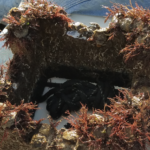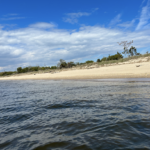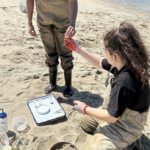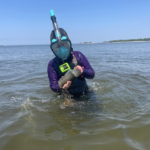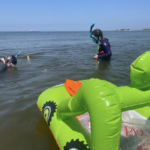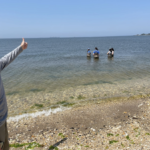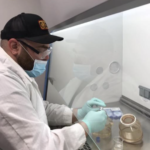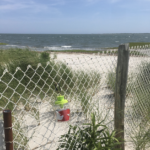Coastal Health Initiative Grant Awardees for 2023
Earlier this year, New Jersey Sea Grant Consortium (NJSGC), The National Oceanographic and Atmospheric Administration (NOAA) Fisheries James J. Howard Marine Sciences Lab (Howard Lab), Congressman Frank Pallone, and the Northeast Fisheries Science Center formed a partnership to fund opportunities for a faculty mentor and their trainees/students from a New Jersey college or university to conduct a research project related to New Jersey coastal health. The teams will receive up to $70,000 for a 2- year project or $35,000 for a 1- year project.
Awardees have been selected for the 2023 Sandy Hook Partnerships in Coastal Studies Research Opportunity. The three projects observe multiple coastal studies, including biodiversity in living shorelines, hard substrate impacts on benthic infaunal communities, and filth fly’s functional biodiversity at wastewater and coastal sites.
The teams will work with the NOAA Fisheries Howard Lab and New Jersey Sea Grant Consortium to accelerate our coastal health research and bring novel ideas and solutions to regional challenges in conservation, management, and sustainability of our coastal marine resources. They will use the Howard Lab’s facilities and contribute to diversity in marine science while working side-by-side with NOAA Fisheries scientists. The students will learn about careers at NOAA Fisheries and receive mentorship to support their development into early career researchers.
Dr. Peter Rowe, Executive Director of New Jersey Sea Grant Consortium notes, “It is important to the Consortium’s core mission to serve New Jersey’s coast and coastal communities through science and research, and even more significant to contribute to workforce development and diversity within the field. NJSGC is excited to aid in supporting these projects and furthering the important relationship between students and their mentors to expand students’ careers into future STEM professionals.”
Dr. Beth Phelan, Chief of the Howard Lab’s Fisheries Ecology Branch, explained, “At NOAA Fisheries, our key values are people, science and service as we carry out our mission to provide the scientific information needed for productive, sustainable and healthy marine ecosystems and coastal communities. Our lab is unique in the mid-Atlantic. We value inclusive partnerships and aim to serve our diverse population equitably. These grants are hopefully the beginning of a bright future.
Project 1: It’s not just oysters! The importance of biodiversity in restoration studies.
PI Mentor: Dr. Allison Fitzgerald afitzgerald@njcu.edu
Mentees: Isabella Soures-Souzam, Lupita Coate, Sonali Rajukar, David Labagais
Oysters are an important part of shallow estuary ecosystems along the Atlantic coast. However, in Raritan Bay and up through the Hudson Estuary in New Jersey, these oyster reefs were decimated by years of overharvesting and pollution. Climate change has led to stronger storm surges along the NJ coastlines, and successful oyster reefs function as a ‘living shoreline’, protecting the shoreline from flooding and damage. Artificial oyster reefs, created with cement structures and living oysters, have been used in NJ successfully; however, after 2-3 years the living oysters die off and recruitment of new oysters is very low. One reason for this could be other organisms growing on the artificial shoreline structures preventing the oysters from coming back.
In order to investigate, the team from New Jersey City University will do a lab and field experiment this summer at Sandy Hook. Oyster castles®, blocks that are used to build artificial reefs, will be placed underwater at Sandy Hook for 2 weeks – 2 months to accumulate colonizing animals and algae on them. Then, these castles will be brought into the NOAA Howard Lab and baby oysters will be placed in the tank. We will observe the castles for 5 weeks to count how many of the oysters attach to the castles.
This project will connect several New Jersey City University undergraduate biology students with the greater marine science community of Raritan Bay and NJ. It will provide an opportunity to work in a government lab using equipment that the students would not have access to at NJCU. The students will learn about experimental design and data collection and analysis techniques. They will also work alongside restoration and aquaculture scientists. This project is also funded by a grant from the NOAA Office of Aquaculture.
- Oyster castle with oysters and algae growing on it.
- Field site at Sandy Hook, located near Horseshoe cove
- Student Isabella identifying organisms in Sandy Hook
Project 2: How do benthic infaunal communities respond to the insertion of hard substrates?
PI Mentor: Dr. Daphne Munroe dmunroe@hsrl.rutgers.edu
Mentee: Sophia Piper
Most of the ocean bottom is composed of soft sediment such as sand or mud. When a hard surface is placed there by humans, animals that prefer to live on hard surfaces like mussels and barnacles are quick to colonize the area, creating an artificial reef. This displaces the animals in the soft sediment. Most research on these interactions focuses on the animals inhabiting the hard structure, but not the soft sediment. Thus, our team from Rutgers University will conduct a field experiment to evaluate the response of the soft sediment community to the insertion of hard surfaces by comparing the community of an existing artificial reef and associated soft sediments with a newly placed hard surface and surrounding soft sediment habitat.
- Sophia Piper surfaces with the core to place in a storage bag and place in Jasper.
- Megan is about to dive for the core, Sophia watches, and in the foreground Jasper the floating lab assistant holds bags and samples.
- Jeff Pessutti points to the site of the first plot.
Project 3: Filth fly (Diptera; Muscidae, Calliphoridae) functional biodiversity at wastewater and coastal sites to explore impact on water associated industries
PI Faculty and Mentor Contact Info: Dr. Nicole Fahrenfeld, nfahrenf@rutgers.edu, Michael Monzon mmonzon@njaes.rutgers.edu and Dr. George Hamilton, hamilton@njaes.rutgers.edu
Mentees: Jakub Nikscin and Emily Sullivan
A collaborative team from Rutgers University’s Departments of Civil and Environmental Engineering, Entomology, and Plant Science will study the potential role of filth-associated flies within the ecology of human and fish diseases. We will sample and test flies from the Sandy Hook Gateway National Recreation Area and a municipal wastewater treatment plant (WWTP) in New Jersey. Our project merges the study of fly biodiversity with studying the microbes like viruses or bacteria in the guts of flies from different locations to learn whether wastewater flies have the same gut microbes as flies from the beach. The main human pathogens of interest are:
- the SARS-CoV-2 virus that causes COVID-19 in humans,
- seafood-borne pathogens like bacteria in the genus Vibrio, and
- the bacterium Aeromonas hydrophila, which are a threat to commercial fish farms.
This project will allow us to draw conclusions about how quickly filth flies become associated with new pathogens found in human waste and provide information about environmental health to people who raise and catch fish in New Jersey.
- Filtering water samples with a vacuum pump
- A fly trap at the beach
